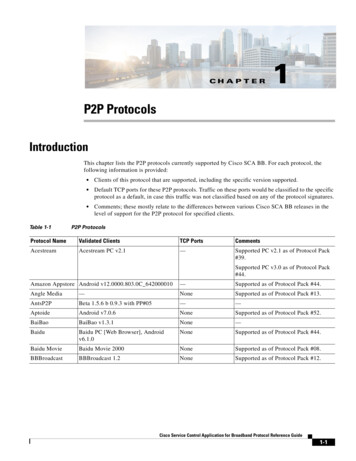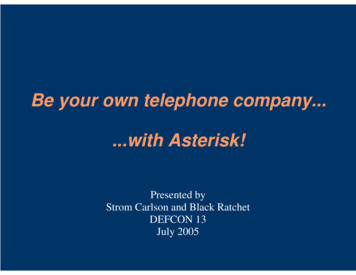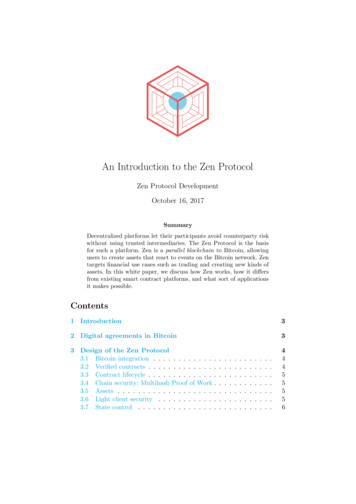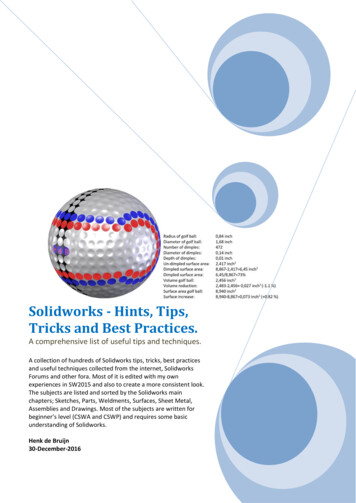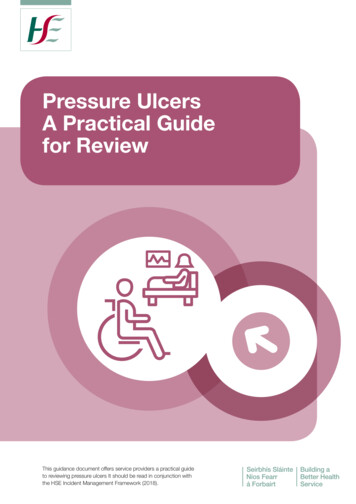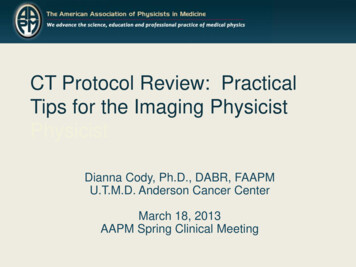
Transcription
CT Protocol Review: PracticalTips for the Imaging PhysicistPhysicistDianna Cody, Ph.D., DABR, FAAPMU.T.M.D. Anderson Cancer CenterMarch 18, 2013AAPM Spring Clinical Meeting
Goals Understand purpose andimportance of CT Protocol Review Understand AAPM MPPG 1.a. Form a CT Protocol ReviewCommittee Utilize AAPM support tools
AAPM Resources
AAPM Medical Physics Practice Guideline 1.a.AAPM CT Protocol Management and ReviewPractice Guideline
Organization of the Practice Guideline1.2.3.4.IntroductionDefinitionsStaffing Qualifications and ResponsibilitiesEssential Elements of the ProtocolManagement Process5. Conclusion6. References
Introduction The review and management of computed tomography(CT) protocols is a facility’s ongoing mechanism of ensuringthat exams being performed achieve the desired diagnosticimage quality at the lowest radiation dose possible whileproperly exploiting the capabilities of the equipment beingused. Therefore protocol review and management is an essentialactivity in ensuring patient safety and that diagnosticimages are produced. The AAPM considers these activities to be essential to anyquality assurance (QA) program for CT, and as anongoing investment in improved quality of patientcare.
Introduction Protocol Management refers to the process of review,implementation and verification of protocols within afacility’s practice. This is a complex undertaking in the present environment.The challenges in optimization of dose and image qualityare compounded by a lack of an automated mechanism tocollect and modify protocols system-wide. The manuallabor involved in identifying, recording, and compiling forreview and subsequent implementation of all relevantparameters of active protocols is not inconsequential [4].
Application of the MPPG This MPPG only applies to CT scanners usedfor diagnostic imaging. It is not applicable toscanners used exclusively for:– Therapeutic radiation treatment planning or delivery;– Only calculating attenuation coefficients for nuclearmedicine studies; or– Image guidance for interventional radiologicprocedures.However, CT protocol review is encouraged in these settings!!
The Team Must be responsible for protocol design and reviewof all parameter settings. Each team member brings different expertise andmay have different responsibilities in the ProtocolReview and Management process. To be successful, it is very important that theexpectations of roles and responsibilities of eachmember are clearly described. The ability to work together as a team will beimportant attributes of each member of this group.
Responsibilities of the QMP In the context of CT Protocol Management andReview, the QMP’s responsibilities may vary,depending on the type of facility they are supporting;regardless, the QMP must be involved in the reviewof all protocols. While regular dialogue is important, the QMPshould also remember that facility personnelthemselves, in particular the Lead CT Radiologist,should lead the CT Protocol Management andReview process; the QMP is an integral member ofthe team. These considerations should be balanced withadequate response times to facility inquiries.
The QMP’s Time A QMP’s time at a facility should include but notbe limited to:– meeting with the CT Protocol Management andReview team; clinical observation;– phantom measurements; side-by-side image reviewwith radiologist(s);– artifact review with technologist(s) and/orradiologist(s);– discussion of equipment performance and operation;etc.
In House QMP This ongoing CT protocol review project mayconsume much of his/her time, so the QMPshould be sure to adequately communicate withhis/her supervisor(s), with other team membersand with department/hospital management in thisregard. The facility should understand that the CTProtocol Management and Review process is anongoing investment in improved quality of patientcare.
In House QMP (continued) In-house QMP’s may be able to arrange morefrequent meetings with CT Protocol Managementand Review team members than their consultingcolleagues; Six to twelve meetings annually may be moreappropriate for facilities with in-house QMP’s, withthe meeting frequency likely decreasing as timegoes on and the facility’s protocols are sufficientlyimproved.
Consulting QMP It is important to note that CT Protocol Managementand Review services are above and beyond normalQMPs consulting services (e.g., the annual physicssurvey), which have traditionally been limited toimage quality, dosimetry and basic protocol review fora few selected examinations. Consultant QMPs should make this clear to theirclients, and negotiate their services appropriately. Consulting QMP’s should work with the facility toarrange mutually agreeable times to visit the facilityfor CT protocol review activities. Three to four visitsannually may be reasonable.
Qualifications and Expectation of theLead CT Technologist The Lead CT Technologist is expected toprovide the interface between the patient, staffand the equipment. This includes workflow, theassembly and management of the CT portfolio,and education of the technologist pool.
Qualifications of the CT Radiologist The CT radiologist leads the CT ProtocolManagement and Review and defines imagequality requirements.
The Protocol ManagementReview Process It is important that the CT Protocol Review andManagement team designs and reviews all new ormodified protocol settings for existing and new scannersto ensure that both image quality and radiation doseaspects are appropriate. While performing the review process, the CT ProtocolManagement team should pay particular attention to theoversight and review of existing protocols along with theevaluation and implementation of new and innovativetechnologies that can improve image quality and/or lowerpatient dose in comparison to the older protocol.
The Protocol ManagementReview Process (continued) Particular attention should be paid to the specificcapabilities of each individual scanner (e.g.,minimum rotation time, automatic exposure controlsincluding both tube current modulation as well as kVselection technologies, iterative reconstruction,reconstruction algorithms, etc.) to ensure maximumperformance of the system is achieved. It should include a review of the most currentliterature.
Considerations Important DuringReview of a Protocol Recommendations for State and NationalGuidance– The QMP must be familiar with applicable federal lawand the specific requirements for the state or localjurisdiction where the facility is located.– Protocol review and management, while not alwaysexplicitly required by state law or regulation, mayoften facilitate compliance with many provisions withinstate laws and regulations relating to radiation dosefrom CT.
Considerations Important DuringReview of a Protocol (continued) Frequency of Review– The review process must be consistent with federal,state and local laws and regulations.– If there is no specific regulatory requirement, thefrequency of protocol review should be no lessfrequent than 24 months.– This review should include all new protocols addedsince the last review.– However, the best practice would be to review afacility's most-frequently-used protocols at leastannually.
Considerations Important DuringReview of a Protocol (continued) Clinically Significant Protocols that Require AnnualReview– If a facility performs the following six clinical protocols, theCT Protocol Review and Management team must review theseannually (or more frequently if required by state or localregulatory body). Pediatric Head (1 year old) (if performed at the institution) Pediatric Abdomen (5 year old; 40-50 lb. or approx. 20 kg)(if performed at the institution) Adult Head Adult Abdomen (70 kg) High Resolution Chest Brain Perfusion (if performed at the institution)
Clinically Significant Protocols thatRequire Annual Review Facilities that do not perform the “six protocols”must select additional protocols at their facility,either the most frequently performed or higherdose protocols, to total at least six for annualreview.
Considerations Important DuringReview of a Protocol (continued) Protocol Naming– Consider naming CT protocols in a manner consistent with theRadLex Playbook ID.– This would provide a more consistent experience for patientsand allow more direct comparison among various facilities.– This practice may also allow more direct utilization of the ACRDose Index Registry tools and provide more efficient automatedprocesses with post-processing workstations.– Appropriate protocol naming will likely result in fewertechnologist errors and allow more efficient comparison ofprotocol parameters between scanners.– Consider incorporating version dates in protocol names toeasily confirm correct version.
Considerations Important DuringReview of a Protocol (continued) Permissions– Each facility should decide and document who has permission tochange protocol parameters on the scanner(s). If the scannerallows password protection of protocols, then the facility isencouraged to use this important safety feature. Facilities shouldalso decide how passwords are protected and archived.– Each facility should decide on the process of making protocoladjustments and the frequency with which these adjustmentsshould be made. This includes decisions as to what approvalsneed to be secured before a protocol adjustment may be made,and the documentation process (e.g., a change control logdocumenting the rationale for each change, as well as whoauthorized or motivated the change).– Each facility should consider how to most effectively utilize theNEMA XR 26 standard (Access Controls for ComputedTomography) [17] when these tools become available onscanners at their facility.
Considerations Important DuringReview of a Protocol (continued) Acquisition Parameters should be reviewed to ensurethey are appropriate for the diagnostic image quality(noise level, spatial resolution, etc.) necessary for theclinical indication(s) for the protocol, while minimizingradiation dose. For example, a slow rotation time and/orlow pitch value would not be appropriate for a chest CTexam due to breath-hold issues. Parameters include:–––––kV,mA,rotation time,collimation or detector configuration,pitch, etc.
Considerations Important DuringReview of a Protocol (continued) Reconstruction parameters should also bereviewed to ensure appropriate diagnostic imagequality (noise level, spatial resolution, etc.) necessaryfor the clinical indication(s) for the protocol. The parameters include: the width of the reconstructed image (image thickness), distance between two consecutive reconstructed images(reconstruction interval), reconstruction algorithm/kernel/filter, the use of additional image planes (e.g., sagittal or coronalplanes, etc.)
Considerations Important DuringReview of a Protocol (continued)– Advanced dose reduction techniques should beconsidered provided the use of such techniques isconsistent with the goals of the exam.– Depending on the capabilities of each specificscanner, consider use of the following if they areavailable: Automatic exposure control (e.g., tube currentmodulation or kV selection) methods Iterative reconstruction techniques
Considerations Important DuringReview of a Protocol (continued) Adjustments of acquisition parametersshould be adjusted for patient size, eitherthrough a series of manual adjustments orthrough the use of automatic techniques (suchas tube current modulation methods that adjustfor patient size).
Considerations Important DuringReview of a Protocol (continued) Radiation dose management tools– Radiation dose management tools that identify whenpotentially high radiation dose scans are being prescribedshould be implemented when available. This includesdose reporting and tracking software, participation in doseregistries and methods as described in the MITA XR25standard (“Dose Check”).– Radiation dose management tools may be used to monitordoses from routine exams and collect data. These wouldallow statistical analysis of dose parameter values for aspecific exam or clinical indication (e.g., average CTDIvolfor a routine non-contrast head). These tools includeparticipation in a national registry (such as the ACR DoseIndex Registry). There are also commercial products nowavailable for this purpose.
Considerations Important DuringReview of a Protocol (continued) Populating Protocols Across Scanners– Each facility should decide on the process by whichprotocol parameters are populated across additionalscanners (whether this is done manually or bycopy/paste if the scanners allow).– The facility should decide whether there are ‘master’scanners in the facility where manual protocoladjustments are to be made and archived, and thatset of protocols moved to the other similar scanners,or if another strategy will be employed.
Considerations Important DuringReview of a Protocol (continued) Documentation– The CT Protocol Review and Management team shouldmaintain documentation of all changes to protocols andhistorical protocols should be available for review.– Documentation should include the rationale for changes.– The latest protocol should be readily and obviouslyavailable to users during clinical protocol selection.– The facility should decide and document who isresponsible for maintaining the overall protocol descriptiondocumentation.– The facility should also describe whether the protocoldescription documentation is accessible to others forreference, how often it is updated and how allprotocols are archived.
Considerations Important DuringReview of a Protocol (continued) Periodic vendor specific education/refreshersessions– Each member of the CT Protocol Management Processteam should receive refresher training no less thanannually or when new technology is introduced thatsubstantially impacts image quality or dose to the patient. Available educational resources should be consideredin order to keep staff updated on current best practices. Periodic refresher training should be scheduled for allmembers of the CT Protocol Management Processteam. Attendance should be taken at initial and all refreshertraining sessions, and consequences identified forfailure to complete training.
Considerations Important DuringReview of a Protocol (continued) Verification– Once a CT Protocol Management Process has beenestablished, the CT Protocol Management Process teammust institute a regular review process of all protocols tobe sure that no unintended changes have been appliedthat may degrade image quality or unreasonably increasedose.– As a best practice, the CT Protocol Review andManagement team should conduct a random survey ofspecific exam types to verify that the protocols used areacceptable and consistent with protocols specified above.This should involve a limited review of recent patientcases to assess: Acquisition and reconstruction parameters, Image quality, and Radiation dose.
Conclusion CT protocol management and review is an importantpart of a CT facility’s operation and is consideredimportant by many state regulatory bodies,accrediting and professional organizations. Protocol parameter control and periodic review willhelp maintain the facility’s image quality toacceptable levels, and will serve to assure patientsafety and continuous improvement in the imagingpractice.
The review and management of computed tomography (CT) protocols is a facility’s ongoing mechanism of ensuring that exams being performed achieve the desired diagnostic image quality at the lowes
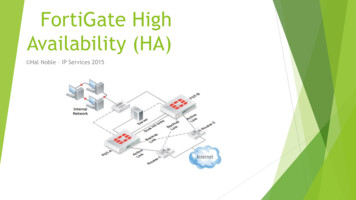
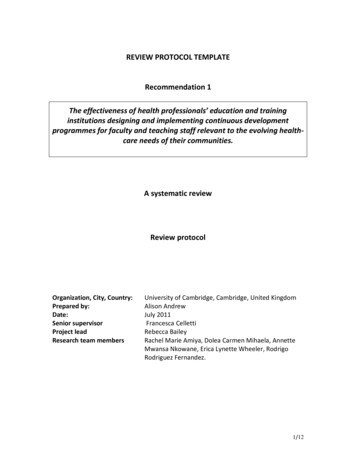
![[MS-OFBA]: Office Forms Based Authentication Protocol](/img/3/ms-ofba.jpg)
